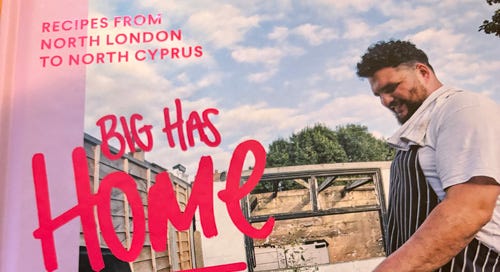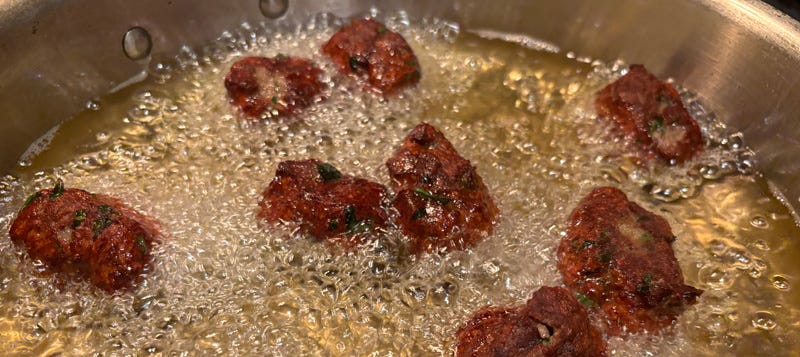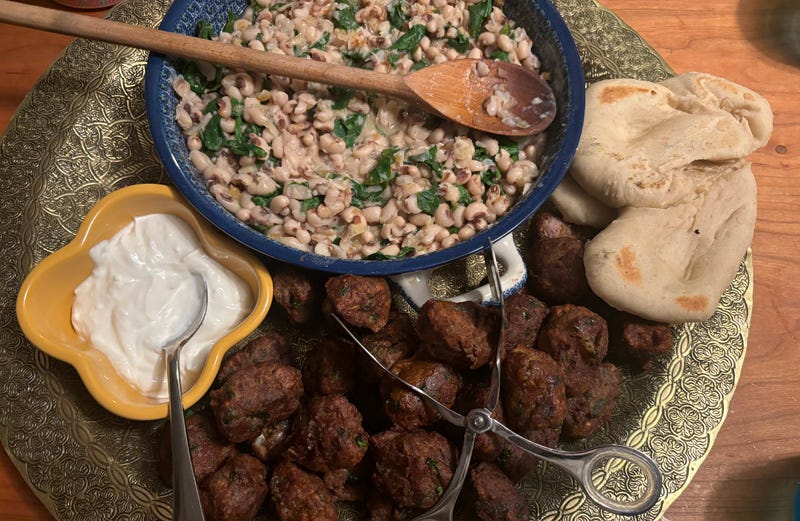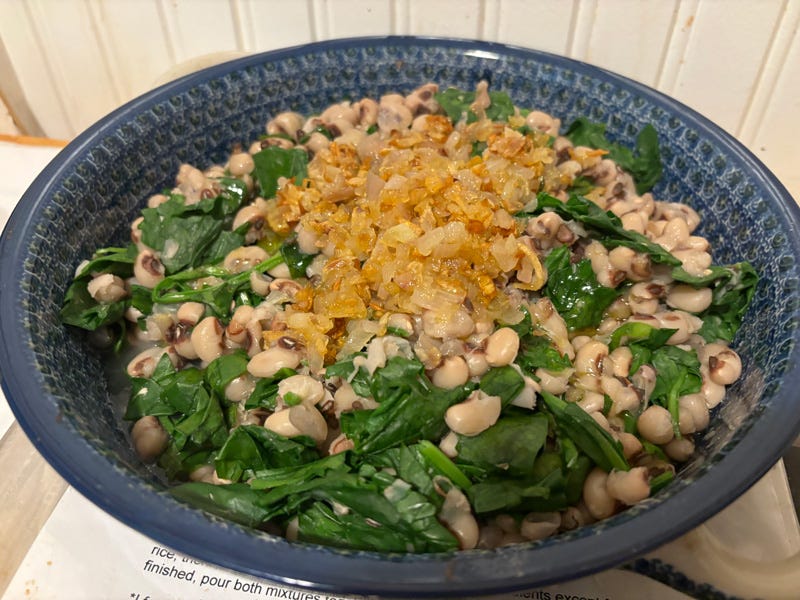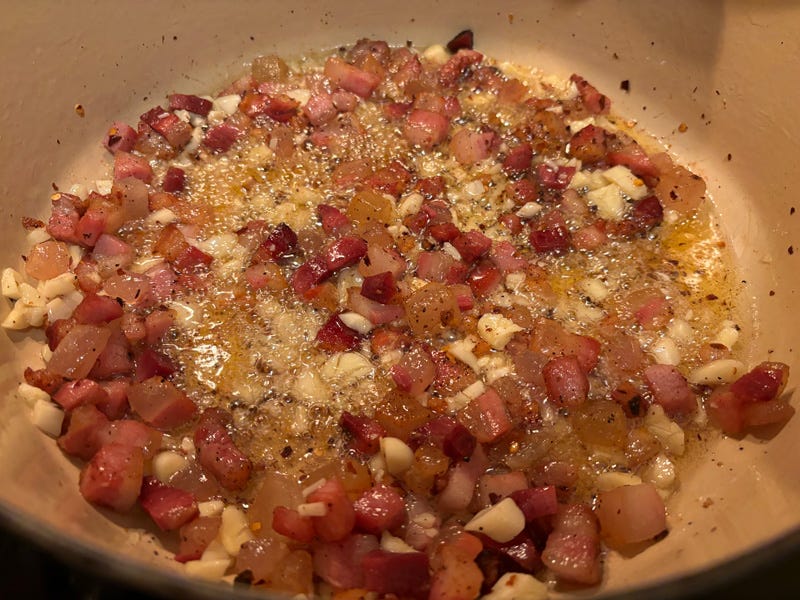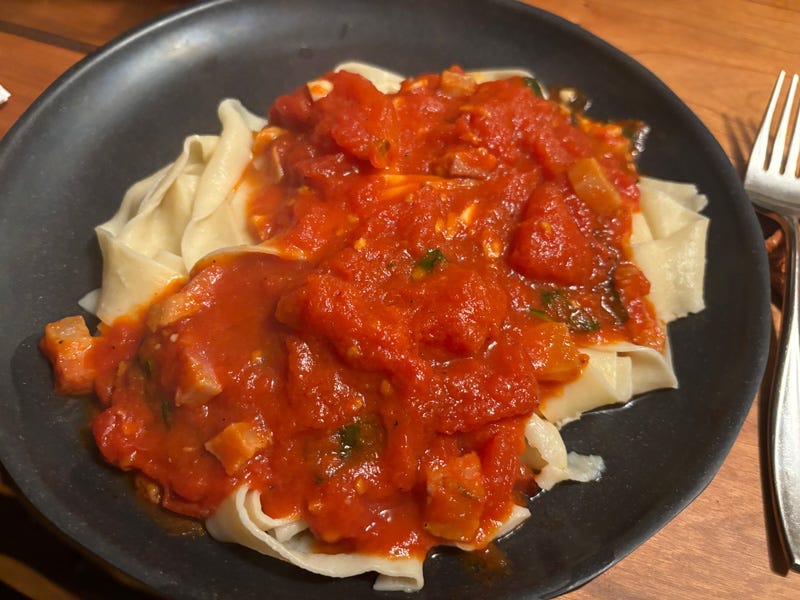THE COOKBOOK TEST #0019: BIG HAS HOME
INSTALLMENT #0019 (PAID) / THE WORLD IS A WEB / FROM YOUTUBE TO BOOK / LAMB AND POTATO KOFTE / AMATRICIANA
Dear Subscribers,
If there is one gift that cooking and eating has given to me that I am more grateful for than anything else, it's the fact that it has made me feel so much more at home in the world. If I'm traveling in New Zealand, I can pop into an izakaya, scan the menu, try the things I haven't seen before, and connect to where I am, where I'm from, and a third place thousands of miles beyond that. I can stroll into a strip mall Vietnamese place and suck down a massive bowl of pho on a cold day while untutored suckers are trying to tame the cold at Noodles and Company. I can talk to my kids about regional Indian cuisines, and talk about colonialism, sectarianism, and the caste system in the process. I can talk to almost anyone, from almost anywhere, about what they eat and have questions to ask, and follow-ups to those questions. Food and eating is this massive global spiderweb, and if you can get comfortable on enough of those strands, you can get comfortable almost anywhere you go.
That's one of the things that caught my eye about BIG HAS HOME, a relatively new cookbook by YouTuber Hasan Semay, whose informal cooking tutorials known as the Sunday Sessions have picked up nearly 43,000 subscribers. The book is an intersection between Hasan's roots in Cyprus and his upbringing in London, with tentacles out to the Turkish side of the Cypriot world, to the Caribbean via the reggae music that virtually pulses through the book's pages, and to Italy via Semay's restaurant cooking resume. This isn't an accidentally global book, a mindless fusion of trendy stuff assembled to appeal to a particular customer profile - it's an edible biography of a specific guy who came from one place to another, kind of grew up and both, and organically reached out other parts of the world in the process.
Home raised the question for me: Where is home? It turns out that home is lots of places. For me home is Madison, Wisconsin, where I was born and raised, and Milwaukee, Wisconsin, where I visited my grandparents and aunts and uncles every major holiday for a couple of decades. It's New York City, where my mom's family is from and where I worked for a bit, and where I felt comfortable the moment I arrived at Grand Central Terminal. And it's Minneapolis-St. Paul, where I work, and live, and raise my kids. For Semay, it's London, and Cyprus, and Turkey, and those homes, all different, all informing one another, all overlapping, deeply inform the book and its recipes.
It's enjoyable to read a book about cooking from someone who hails from a different set of homes than I do. Home is a cool read.
at your service,
James
BIG HAS HOME: RECIPES FROM NORTH LONDON TO NORTH CYPRUS
BY HASAN SEMAY
HARPER COLLINS | 2022 | $28.99
Big Has has a great screen presence - his narration is accented but easy to follow, peppered with lively obscenities and set in a cramped, weed-clogged urban backyard that's about as far from a Martha Stewart or Barefoot Contessa set as you can imagine. His equipment is utile and accessible, his tools are simple, and he focuses his attention on the ingredients and the process at hand, not the decor and the gadgets.
You wouldn't think that kind of YouTube appeal would transfer through to a book, but it really does - the narration of the book is his voice, the story that opens the book is lengthy and earthy and personal, and the recipes all revolve around places he's been, people he's known, and things he's personally loved to cook and/or eat.
This book is wordy, and that's not bad. Most of the really good recipes that I rely upon are good because I've worked out their pain points, and I know when something isn't working and I need to pivot in terms of timing or prep. Big Has writes recipes that are about four or five times longer than they absolutely need to be and that's great - it's a chance to virtually hang out with an interesting guy, and it's a chance to get into his head and figure out what makes his cooking tick.
LAMB AND POTATO KOFTE
One of my favorite things to make with and for my son Joe are kofte kebabs. Our go-to recipe uses lamb and onions, but doesn't (as Big Has's does) use potatoes, so I was intrigued by this substantial variation from what I've seen and tasted before. I'm also used to throwing these things on the grill, but this Cyprus-derived recipe leans into shallow-frying in a saute pan, instead. Curious stuff!
For the recipe below, I've scaled things down to a single pound of lamb from the original pound and a half. It fit my four-person family's appetite more accurately, and is the unit of lamb available for sale around my (American) cityscape.
Recipe notes: now that I've cooked the kofte, I can say the scaled-down version was about double what we needed for dinner. So I'm calling my version "serves about eight." The original probably serves 12+, despite being described as serving four. It’s possible Cypriots are big eaters.
The black-eyed beans and spinach that come as a side dish with the kofte were a revelation. Just delicious. And this bit of writing from the book captures the magic so ably:
At this point you need to taste the mixture and you'll probably find it's a little flat - you'll have a little saltiness but nothing will really be singing. Squeeze in the lemon juice and taste again. Now the acidity is up our tongues are entertained, and you want to mellow that acidity out with peppery olive oil.
Spot on - the seasoning absolutely makes this dish. I hit my version with another blast of salt for good measure, and that was the right choice - it's reflected in my directions, below.
The potato kofte are creamy and almost aggressively potato-forward - really straddling the line between "kebab" and "tater tot," although smoother and more consistent than either. All said, I enjoyed these kebabs quite a bit (particularly with homemade pita and garlic-lemon-yogurt sauce), but going forward I will stick with my more conventional lamb kebabs because they spare me the punishing ordeal of trying to process massive amounts of potatoes (and a fair bit of onions) via a box grater. If you're going to attempt this recipe, you might consider using a grater setting on a food processor and letting me know how it turns out. It'll probably turn out alright.
I also reduced the amount of salt for the kebabs in my recipe below by about 20% - the original tasted good, but over the top.
NOTE: The original Big Has recipe directions intersplice the kofte and black-eye beans methods. I found that confusing from a timing perspective, so I disentangled the two recipes - you can time them out as you wish.
LAMB AND POTATO KOFTE
Serves about Eight
30 oz. potatoes, peeled (ideally Cyprus but I used russets)
18g sea salt
8g freshly ground black pepper
1 1/2 tsp cumin seeds, crushed
2 tsp pul biber (I used paprika)
1 1/4 large onions, grated
1 pound minced lamb shoulder
sunflower or other oil for frying (I used vegetable oil)
a bunch of flat-leaf parsley, finely chopped
Grate the potatoes on the fine side of a box grater. This will be tedious. Using a cheesecloth, squeeze off extra moisture and put the grated potatoes in a large bowl and season with the salt, black pepper, cumin, and pul biber.
Grate the onions on the fine side of a box grater. This will be horrible work. I got about 50-65% of my onions actually grated and chucked the rest, tears choking my eyes, curses tumbling from my mouth. Add the onions to the bowl, along with their juice, the minced lamb, and the parsley. Use your hands to really mix the kebabs for about two or three minutes, just squeeze the bejeezus out of them as you mix.
At this point, if you want to throw your kebab mix in the fridge, you can shape and fry them later.
When ready: Shape the kebabs into torpedos or meatballs, staging them on a plate or pan. In a tall-sided sauce pan, add oil to about half the height of the kebabs. Heat your oil at medium-high to about 325-330 degrees and turn the kebabs halfway through cooking, about 4-5 minutes per side.
BLACK-EYED BEANS AND SPINACH
Serves about Eight
330 g black-eyed beans (also known as black-eyed peas)
6 oz. spinach, chopped
7 oz. shallots, finely diced
juice of 1 1/2 lemons
sea salt
good quality extra virgin olive oil
Using your preferred method, get your black eyed beans to a point where they're cooked but not mushy. I used dried beans, so this involved a two-minute boil followed by an hour-long soak followed by a drain, a rinse, and then a simmer in fresh water. The bag said to simmer for 60-90 minutes, but in about 45 they were already overcooked, and starting to go mushy. That said, the final recipe turned out well, so if you err toward overcooked you're still OK.
Before your beans are done (with 10-20 minutes to go), saute your shallots in a pan with olive oil and a generous amount of salt (about 1-2 tsp) for about 15 minutes on medium-low heat. Sweat them until they're soft and sweet, without much color.
Now that you've got properly cooked beans, stir in your chopped spinach and turn off the heat. Let it cook for a minute or two, then drain the beans and spinach and move them into a bowl or serving dish. Stir in your shallots. Taste the mixture, and start adding lemon juice - maybe about half of what you've got - and taste again. Add some salt - probably 2-3 tsp - and stir it in. Taste again, and adjust salt and lemon juice to taste. By now, this stuff should be delicious.
AMATRICIANA
I couldn't pass up the chance to test Big Has's take on Amatriciana, a zesty, full-flavored red sauce that I used to buy by the quart from Capone's, a seriously good Italian deli in the Boston suburb of Somerville. Amatriciana's a simple sauce - it's driven by partially rendered and crispy guanciale, garlic, basil, and red chili flakes. It packs some heat and the richness of the pork, brightened up by San Marzano tomatoes. Guanciale is absolutely key to this sauce - if you can't get it, forget it. I ended up sourcing mine at a Minneapolis Italian deli called Capone's (no relation!), for about $30 a pound, which was enough to make a huge double batch of sauce.
Ultimately: I liked the Big Has take on amatriciana and thought it came out well. He emphasizes leaving the guanciale partially rendered; I'd render it more aggressively next time to cut back on some of the chewiness. That's a matter of taste. I ended up adding 1/2 tsp of salt to finish the sauce, and slightly upping the red chili flakes. I might also simmer my next version for a longer period of time - the Big Has amatriciana is brighter, lighter, and less homogenized than what I'm used to, which is in no way a bad thing - I've just gotten used to a bigger, badder, thicker version of this sauce.
The author's recipe has a method for blanching and peeling fresh San Marzano tomatoes, and if you've got access to them, and a lot of patience, please knock yourself out. Business Costco carries 6 pound cans of them for a reasonable price, they're perfect for making a double recipe.
Home features a couple of recipes for fresh pasta, but, honestly, if you get one of those things to actually work for you, you stick with it like a good marriage. I'm married to my method, you can read it below.
Home also included about two paragraphs about how to sauce pasta, which I appreciate, but do regard as overkill.
AMATRICIANA
3lb 3oz. San Marzano tomatoes
7 oz. guanciale, skin removed, cut into small cubes
55g garlic cloves, thinly sliced (this is a lot of garlic, like most of a head)
1 tsp chili flakes (I went a little harder, you should too)
10 fresh basil leaves
serve on pasta, finish with good olive oil and Pecorino cheese
Add the guanciale to a frying pan and turn it on to medium heat. Let it render and crisp up a little on all sides. Keep as much or little chew as you like.
Add the garlic and chili flakes, and let them fry gently without coloring.
Add the tomatoes (crushing them with your hands as you do, it’s fun) and any extra tomato sauce if using canned. Bring your heat to a boil, and then simmer on medium-low until the moisture from the tomatoes cooks off and you're left with a thick sauce. Stir through the basil and serve.
FRESH PASTA
Serves two, scale up as you see fit
Put 1 cup of flour in a bowl, mix it with a 1/2 tsp of salt, and make a well. Crack an egg into that well, and use your fork to incorporate it into the flour. Once thoroughly incorporated, knead it for 5-10 minutes until it’s glossy and somewhat elastic, then let it rest for 20 minutes. You may introduce a little water to get it to cohere, but do it slowly and stingily. Too much water and your dough will tear apart as you run it through a pasta machine.
Use a rolling pin to roll out about half the dough into a rectangle that can fit through your pasta machine’s widest setting. Run it through 2-3 times on that setting, then get progressively smaller, occasionally folding it over double and running through twice on a single setting to temper and even it out. I usually stop on the penultimate setting, which is plenty thin. Use a knife or pizza cutter to cut noodles, and boil them for 3-4 minutes in salted water.

